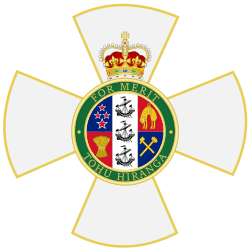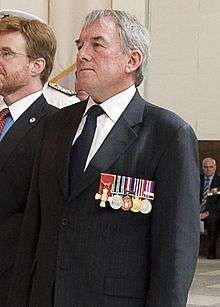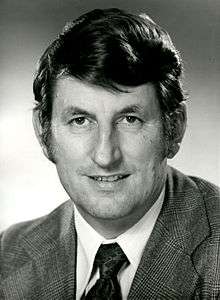New Zealand Order of Merit
The New Zealand Order of Merit is an order of merit in New Zealand's honours system. It was established by royal warrant on 30 May 1996 by Elizabeth II, Queen of New Zealand, "for those persons who in any field of endeavour, have rendered meritorious service to the Crown and nation or who have become distinguished by their eminence, talents, contributions or other merits",[1] to recognise outstanding service to the Crown and people of New Zealand in a civil or military capacity.
| New Zealand Order of Merit | |
|---|---|
 Badge of the Order | |
| Awarded by the monarch of New Zealand | |
| Type | National order of merit |
| Motto | For Merit—Tohu Hiranga |
| Eligibility | Citizens of Commonwealth realms |
| Criteria | Meritorious service to the Crown and the nation or who have become distinguished by their eminence, talents, contributions, or other merits |
| Status | Currently constituted |
| Sovereign | Queen Elizabeth II |
| Chancellor | Dame Patsy Reddy |
| Grades |
|
| Statistics | |
| Last induction | 2020 New Year Honours |
| Precedence | |
| Next (higher) | Order of New Zealand |
| Next (lower) | Queen's Service Order |
Ribbon of the New Zealand Order of Merit | |
In the order of precedence, the New Zealand Order of Merit ranks immediately after the Order of New Zealand.
Creation
Prior to 1996 New Zealanders received appointments to various British orders, such as the Order of the Bath, the Order of St Michael and St George, the Order of the British Empire, and the Order of the Companions of Honour, as well as the distinction of Knight Bachelor.[2] The change came about after the Prime Minister's Honours Advisory Committee (1995) was created "to consider and present options and suggestions on the structure of a New Zealand Royal Honours System in New Zealand, which is designed to recognise meritorious service, gallantry and bravery and long service".[3]
Composition

The monarch of New Zealand is the Sovereign of the order and the Governor-General is its Chancellor. Appointments are made at five levels:
- Knight or Dame Grand Companion (GNZM)
- Knight or Dame Companion (KNZM or DNZM)
- Companion (CNZM)
- Officer (ONZM)
- Member (MNZM).
From 2000 to 2009, the two highest levels of the Order were Principal Companion (PCNZM) and Distinguished Companion (DCNZM), without the appellation of "Sir" or "Dame".[4][5]
The number of Knights and Dames Grand Companion (and Principal Companions) is limited to 30 living people. Additionally, new appointments are limited to 15 Knights or Dames Companion, 40 Companions, 80 Officers and 140 Members per year.[6]
As well as the five levels, there are three different types of membership. Ordinary membership is limited to citizens of New Zealand or a Commonwealth realm. "Additional" members, appointed on special occasions, are not counted in the numerical limits. People who are not citizens of a Commonwealth realm are given "Honorary" membership; if they subsequently adopt citizenship of a Commonwealth realm they are eligible for Additional membership.[7]
There is also a Secretary and Registrar (the Clerk of the Executive Council) and a Herald (the New Zealand Herald of Arms) of the Order.
Insignia and other distinctions

- The Collar, worn only by the Sovereign and Chancellor, comprises "links of the central medallion of the badge" and "S"-shaped Koru, with the Coat of Arms of New Zealand in centre. Hanging from the Coat of Arms is the badge of the Order.
- The Star is an eight-pointed star with each arm bearing a representation of a fern frond, with the Order's badge superimposed in the centre. Grand Companions wear a gold star and Knight Companions wear a silver star.
- The Badge for the three highest classes is a gold and white enamel cross with curved edges bearing at its centre the coat of arms of New Zealand within a green enamel ring bearing the motto For Merit Tohu Hiranga, topped by a royal crown. The badge for Officers and Members is similar, but in silver-gilt and silver respectively. Grand Companions wear the badge on a sash over the right shoulder (though the Governor-General usually wears it as a neck decoration in lieu of the Collar); Knight Companions and Companions wear the badge on a neck ribbon (men) or a bow on the left shoulder (women). Officers and Members wear the badge from a ribbon on the left lapel (men) or a bow on the left shoulder (women).
- The ribbon and sash are plain red ochre.
Knight/Dames Grand Companion and Knight/Dames Companion are entitled to use the style Sir for males and Dame for females.
The order's statutes grant heraldic privileges to members of the first and second level, who are entitled to have the Order's circlet ("a green circle, edged gold, and inscribed with the Motto of the Order in gold") surrounding their shield. Grand Companions are also entitled to heraldic supporters. The Chancellor is entitled to supporters and a representation of the Collar of the Order around his/her shield.[8]
Office holders
- Sovereign: Elizabeth II[9]
- Chancellor and Principal Dame Grand Companion: The Governor-General, Dame Patsy Reddy[10]
- Secretary and Registrar: Michael L. C. Webster (18 March 2014)[11]
- Herald: Philip O'Shea CNZM CVO (23 September 1996)[12]
Living Grand and Principal Companions
| No. | Name | Portrait | Honour | Date of appointment | Known for | Present age |
|---|---|---|---|---|---|---|
| 1 | Sir William Birch GNZM PC JP |  | Knight Grand Companion | 7 June 1999 | 38th Minister of Finance | 86 |
| 2 | Dame Sian Elias GNZM PC QC | .jpg) | Dame Grand Companion | 7 June 1999 | 12th Chief Justice of New Zealand | 71 |
| 3 | Sir Lloyd Geering ONZ GNZM CBE | .jpg) | Knight Grand Companion | 30 December 2000 | Theological scholar | 102 |
| 4 | Dame Silvia Cartwright PCNZM DBE QSO DStJ | .jpg) | Principal Companion | 20 March 2001 | Former Governor-General | 76 |
| 5 | Dame Malvina Major ONZ GNZM DBE | .jpg) | Dame Grand Companion | 31 December 2007 | Opera singer | 77 |
| 6 | Sir Ray Avery GNZM | .jpg) | Knight Grand Companion | 31 December 2010 | Pharmaceutical scientist | 73 |
| 7 | Sir Murray Brennan GNZM | .jpg) | Knight Grand Companion | 31 December 2014 | Surgeon, cancer researcher & medical academic | 80 |
| 8 | Sir John Key GNZM AC | .jpg) | Knight Grand Companion | 5 June 2017 | 38th Prime Minister of New Zealand | 59 |
| 9 | Sir Stephen Tindall GNZM | .jpg) | Knight Grand Companion | 31 December 2018 | Businessman and philanthropist | 69 |
| Additional appointments | ||||||
| Sir Michael Hardie Boys GNZM GCMG QSO KStJ |  | Knight Grand Companion | 3 June 1996 | Former Governor-General | 88 | |
| Sir Anand Satyanand GNZM QSO KStJ | .jpg) | Knight Grand Companion | 5 June 2006 | Former Governor-General | 76 | |
| Sir Jerry Mateparae GNZM QSO KStJ | .jpg) | Knight Grand Companion | 20 May 2011 | Former Governor-General | 65 | |
| Dame Patsy Reddy GNZM QSO DStJ | .jpg) | Dame Grand Companion | 27 June 2016 | Governor-General | 66 | |
| Dame Helen Winkelmann GNZM | .jpg) | Dame Grand Companion | 4 March 2019 | 13th Chief Justice of New Zealand | 58 | |
Living Distinguished Companions
The following contains the names of the small number of living Distinguished Companions (DCNZM) who chose not to convert their appointment to a Knight or Dame Companion, and thus not to accept the respective appellation of "Sir" or "Dame". The majority of those affected chose the aforereferenced appellations.
| Name | Portrait | Date of appointment | Known for | Present age |
|---|---|---|---|---|
| Vincent O’Sullivan DCNZM | 5 June 2000 | Writer and actor | 82 | |
| Witi Ihimaera DCNZM QSM | .jpg) | 7 June 2004 | Writer | 77 |
| Penny Jamieson DCNZM | 7 June 2004 | Former Bishop of Dunedin | 78 | |
| Joy Cowley ONZ DCNZM OBE | .jpg) | 6 June 2005 | Writer | 84 |
| Sam Neill DCNZM OBE |  | 30 December 2006 | Actor | 72 |
| Patricia Grace DCNZM QSO | 4 June 2007 | Writer | 83 | |
| Margaret Wilson DCNZM | 31 December 2008 | Former Speaker of Parliament | 73 |
Controversy
A change to non-titular honours was a recommendation contained within the original report of the 1995 honours committee (The New Zealand Royal Honours System: The Report of the Prime Minister’s Honours Advisory Committee) which prompted the creation of the New Zealand Order of Merit. Titular honours were incorporated into the new system before its implementation in 1996 after the National Party caucus and public debate were split as to whether titles should be retained.[3]
There has long been debate in New Zealand regarding the appropriateness of titles. Some feel it is no longer appropriate as New Zealand has not been a colony since 1907, and to these people titles are out of step with present-day New Zealand. Others feel that titles carry both domestic and international recognition, and that awarded on the basis of merit they remain an appropriate recognition of excellence.
In April 2000 the then new Labour Prime Minister, Helen Clark, announced that knighthoods and damehoods had been abolished and the order's statutes amended. From 2000 to 2009, the two highest levels of the Order were Principal Companion (PCNZM) and Distinguished Companion (DCNZM), without the appellation of "Sir" or "Dame"; appointment to all levels of the Order were recognised solely by the use of post-nominal letters.[4][5]
A National Business Review[13] poll in February 2000 revealed that 54% of New Zealanders thought the titles should be scrapped. The Labour Government's April 2000 changes were criticised by opposition parties, with Richard Prebble of the ACT New Zealand party deriding the PCNZM's initials as standing for "a Politically Correct New Zealand that used to be a Monarchy".
The issue of titular honours would appear whenever honours were mentioned. In the lead up to the 2005 general election, Leader of the Opposition Don Brash suggested that should a National-led government be elected, he would reverse Labour's changes and re-introduce knighthoods.[14]
In 2009, Prime Minister John Key (later to become a Knight Grand Companion himself) restored the honours to their pre-April 2000 state. Principal Companions and Distinguished Companions (85 people in total) were given the option to convert their awards into Knighthoods or Damehoods.[15] The restoration was welcomed by Monarchy New Zealand.[16] The option has been taken up by 72 of those affected, including rugby great Colin Meads.[17] Former Labour MP Margaret Shields was one of those who accepted a Damehood, despite receiving a letter from former Prime Minister Helen Clark "setting out why Labour had abolished the titles and saying she hoped she would not accept one".[18] Clark's senior deputy, Michael Cullen, also accepted a knighthood.
Appointments have continued under the Sixth Labour Government of New Zealand, the first time Labour has been in government since 2008. The 2018 New Year Honours included seven knights and dames. The government has not commented on its position regarding knighthoods and damehoods, but the Prime Minister did specifically congratulate two women on becoming Dames Companion.[19]
See also
- 2009 Special Honours (New Zealand)
- Living New Zealand dames and knights
- New Zealand campaign medals
- Orders, decorations, and medals of New Zealand
- Orders and decorations of the Commonwealth realms
- Order of Australia
- Order of Canada
References
- "New Zealand Royal Honours". Department of Prime Minister and Cabinet. Retrieved 21 August 2013.
- Prime Minister's Office (2 May 1996). "The New Zealand Order of Merit". New Zealand Executive Government News Release Archive. Retrieved 22 February 2006.
- "The Review of the New Zealand Royal Honours System". New Zealand Numismatic Journal, Proceedings of the Royal Numismatic Society of New Zealand (75): 17–21. 1997. Archived from the original on 27 October 2009.
- "Additional Statutes of The New Zealand Order of Merit (SR 2000/84)". NZ Parliamentary Counsel Office. Retrieved 15 October 2016.
- "Titles discontinued". New Zealand Defence Force. 10 April 2000. Retrieved 5 July 2016.
- Statutes of the New Zealand Order of Merit (SR 1996/205), reg 9
- Statutes of the New Zealand Order of Merit (SR 1996/205), regs 6-11
- Statutes of the New Zealand Order of Merit (SR 1996/205), reg 50
- Statutes of the New Zealand Order of Merit (SR 1996/205), reg 4
- Statutes of the New Zealand Order of Merit (SR 1996/205), reg 5
- "The Queen's Service Order / The Order of New Zealand / The New Zealand Order of Merit". New Zealand Gazette (44): 1287. 28 April 2014.
- "The New Zealand Order of Merit". New Zealand Gazette (130): 3198. 26 September 1996.
- National Business Review 24 March 2000
- Milne, Jonathan; Spratt, Amanda (5 September 2005). "Brash plans to bring back knighthoods". The New Zealand Herald. Retrieved 15 June 2006.
- Prime Minister's Office (8 March 2009). "Titular Honours to be reinstated". New Zealand Government. Archived from the original on 22 May 2010. Retrieved 8 March 2009.
- "Press Release – Knighthoods restored". Monarchist League of New Zealand. 15 March 2009. Archived from the original on 7 August 2009.
- "Colin 'Pinetree' Meads to take knighthood". NZPA. 12 May 2009.
- Young, Audrey (14 August 2009). "Helen Clark Loses: Ex-Labour MP takes Title". The New Zealand Herald.
- Prime Minister congratulates Honours recipients
External links
- The New Zealand Order of Merit at Department of the Prime Minister and Cabinet. Accessed 8 July 2013.
- NZDF Medals – The New Zealand Order of Merit (Images)
- Statutes of the New Zealand Order of Merit by Royal Warrant of 30 May 1996 (SR 1996/205). Accessed 22 February 2006.
- ODM – New Zealand Order of Merit (Images)